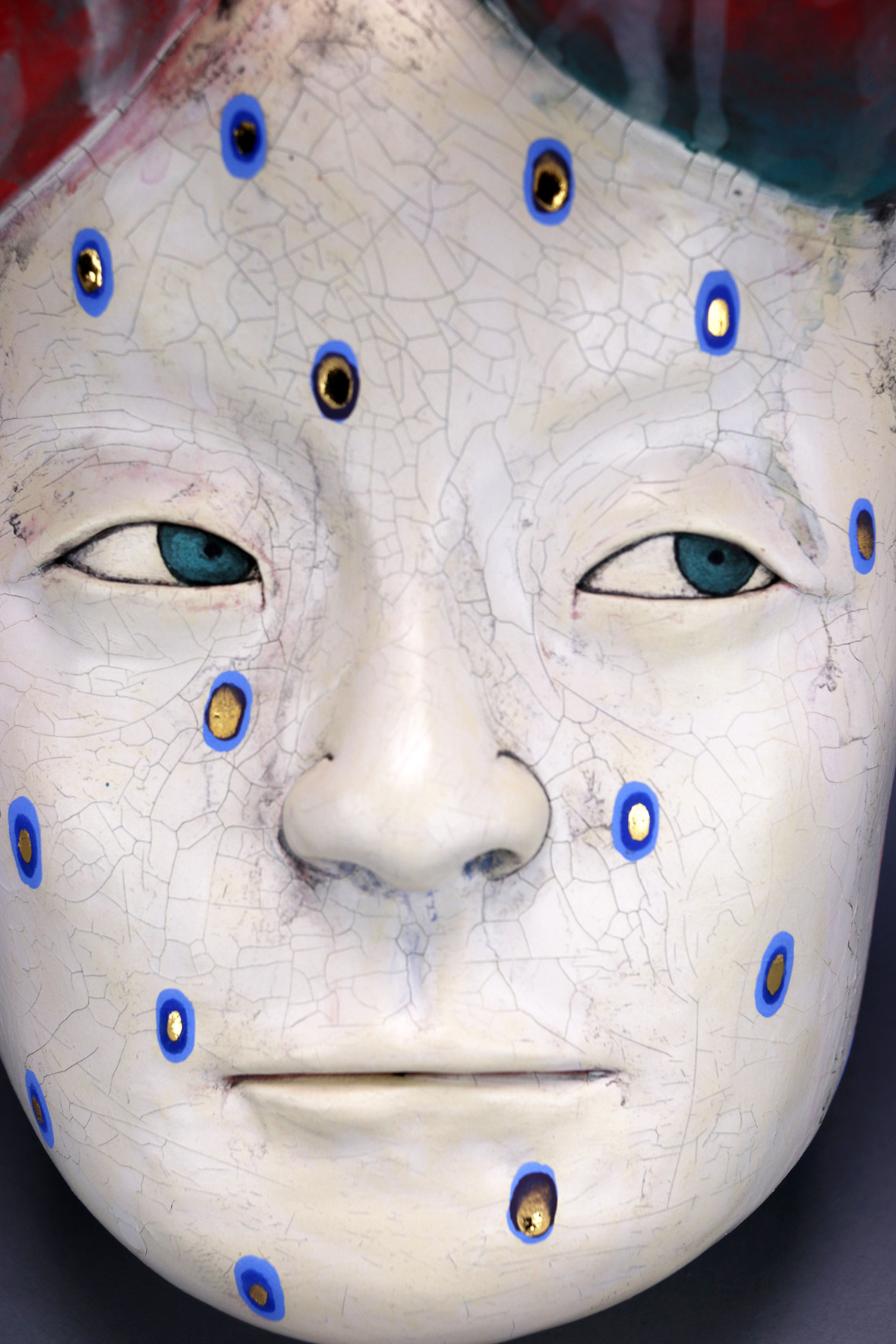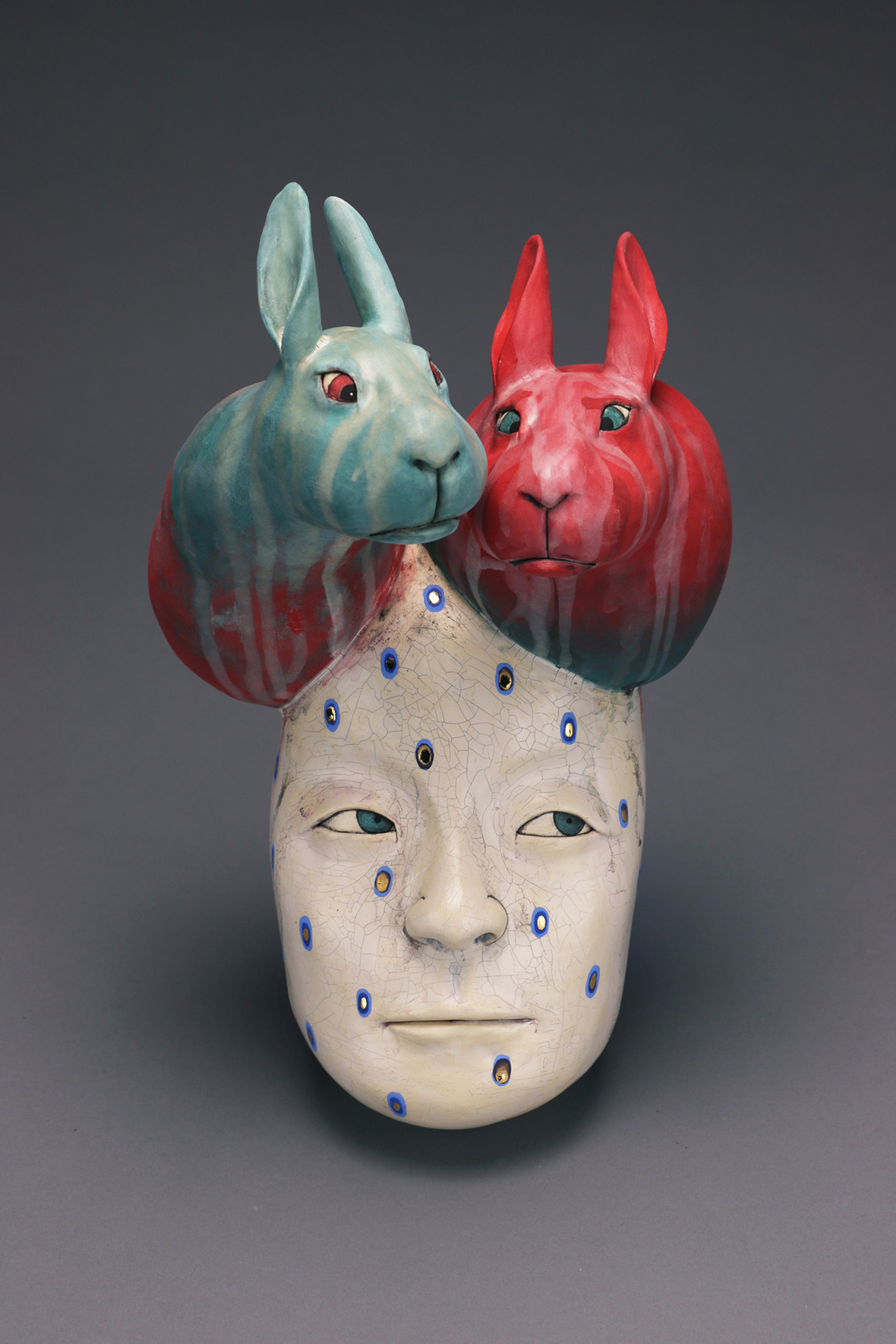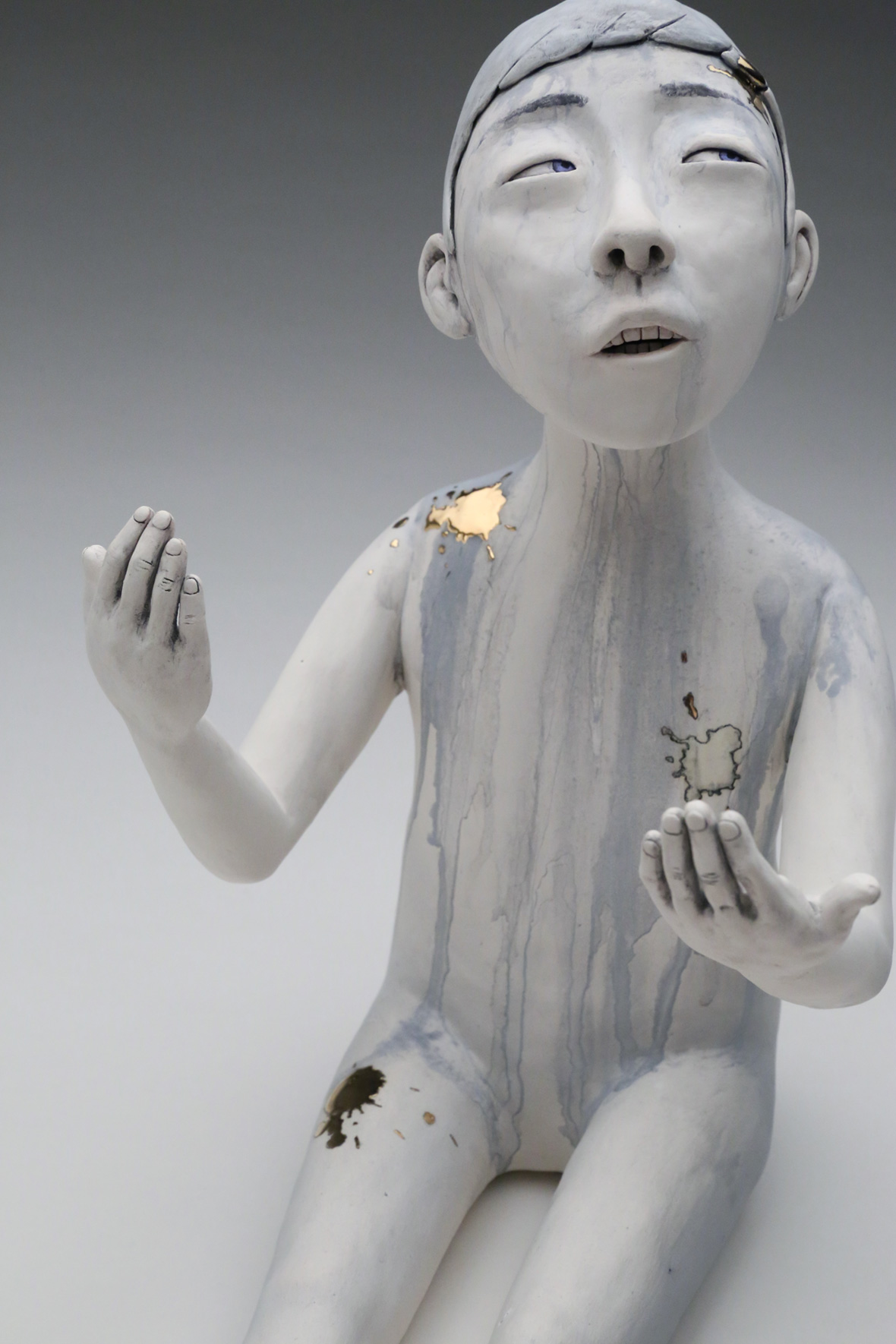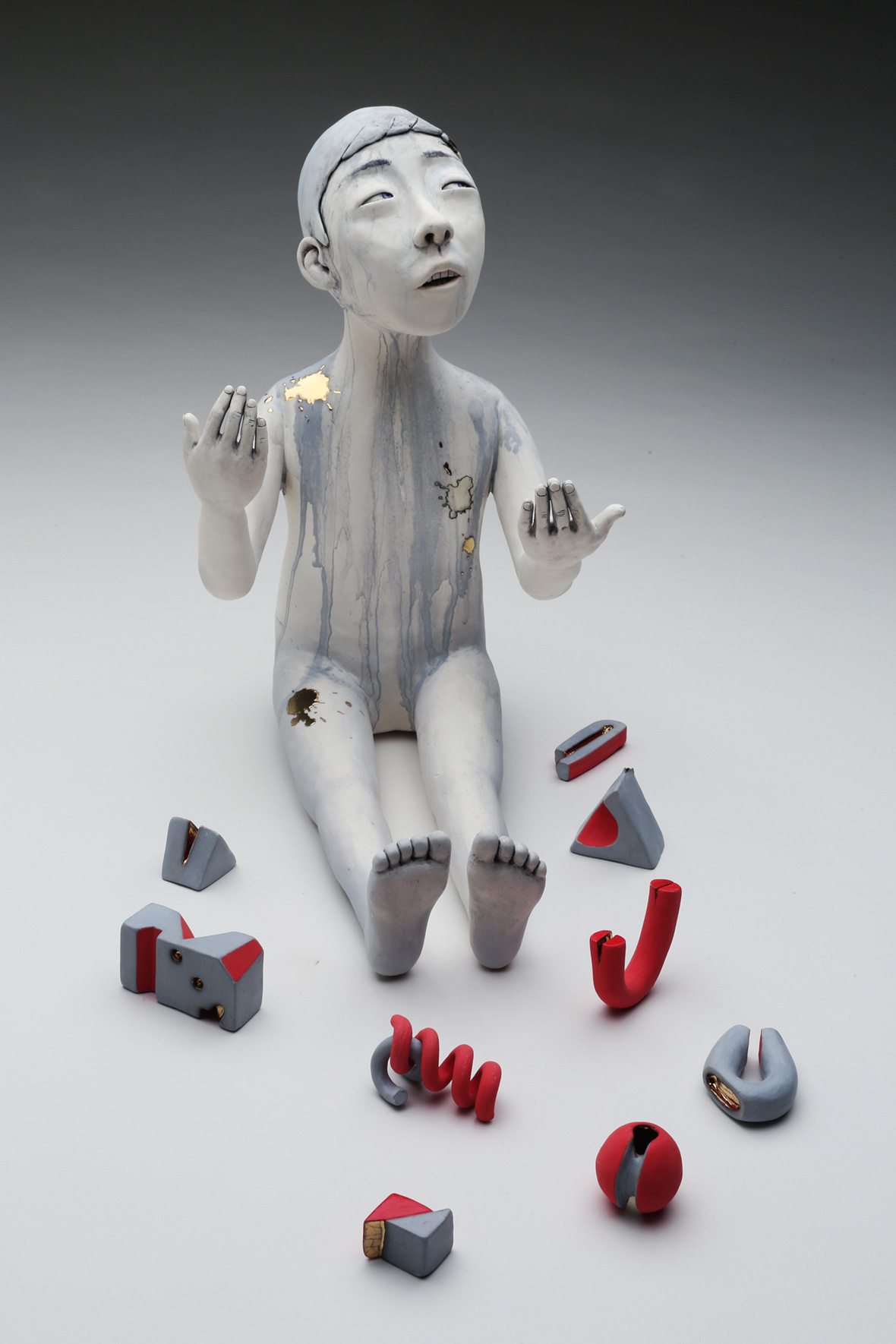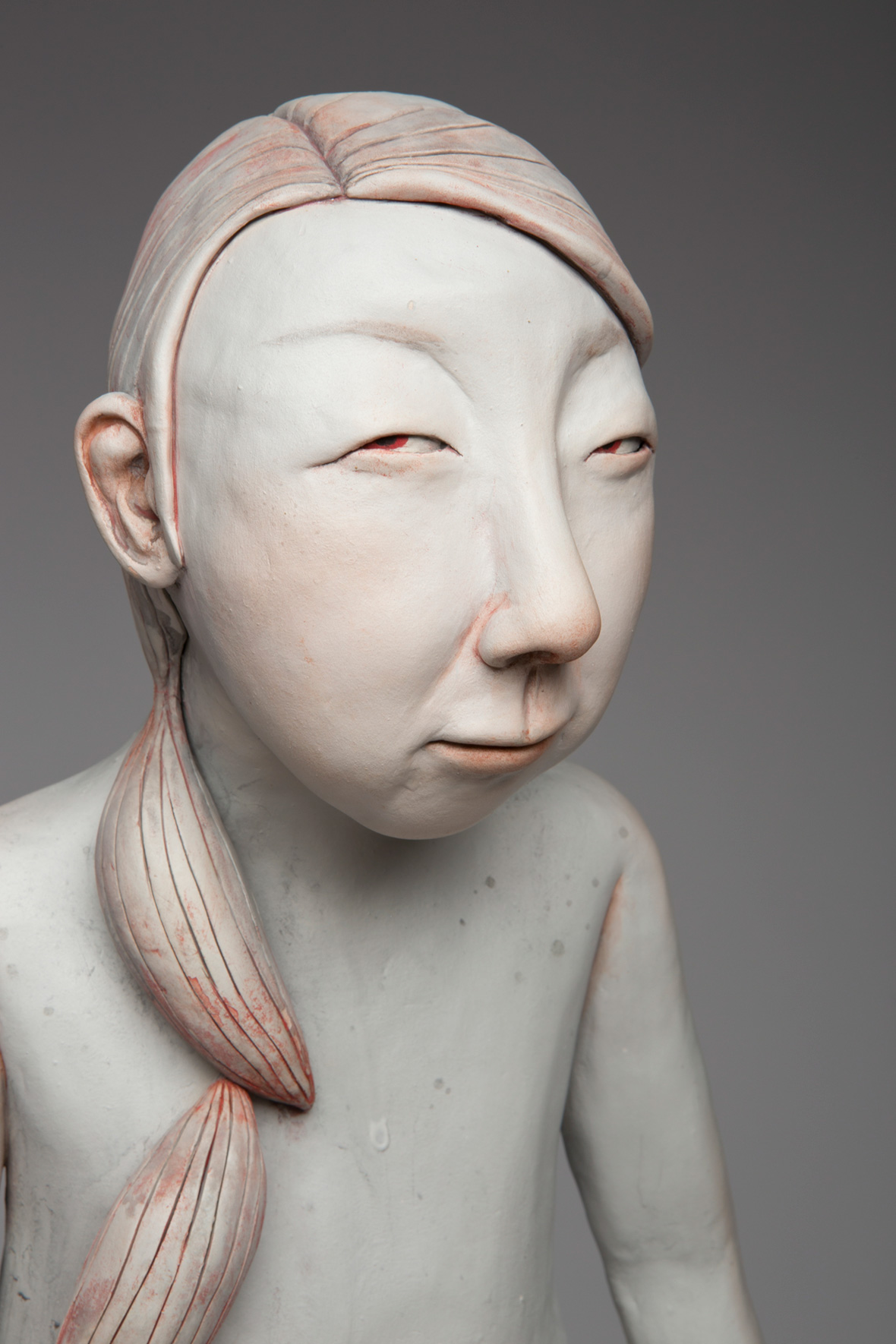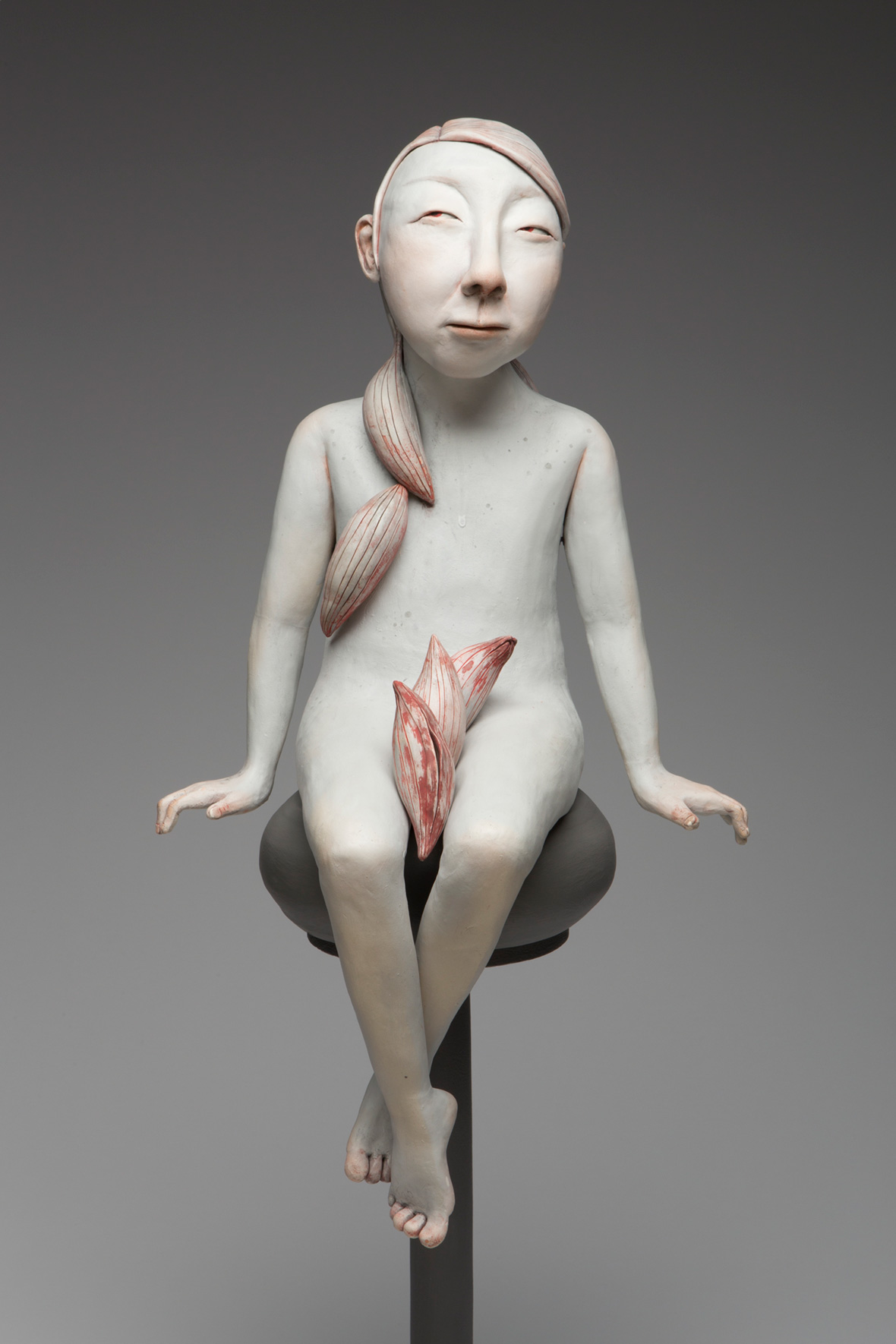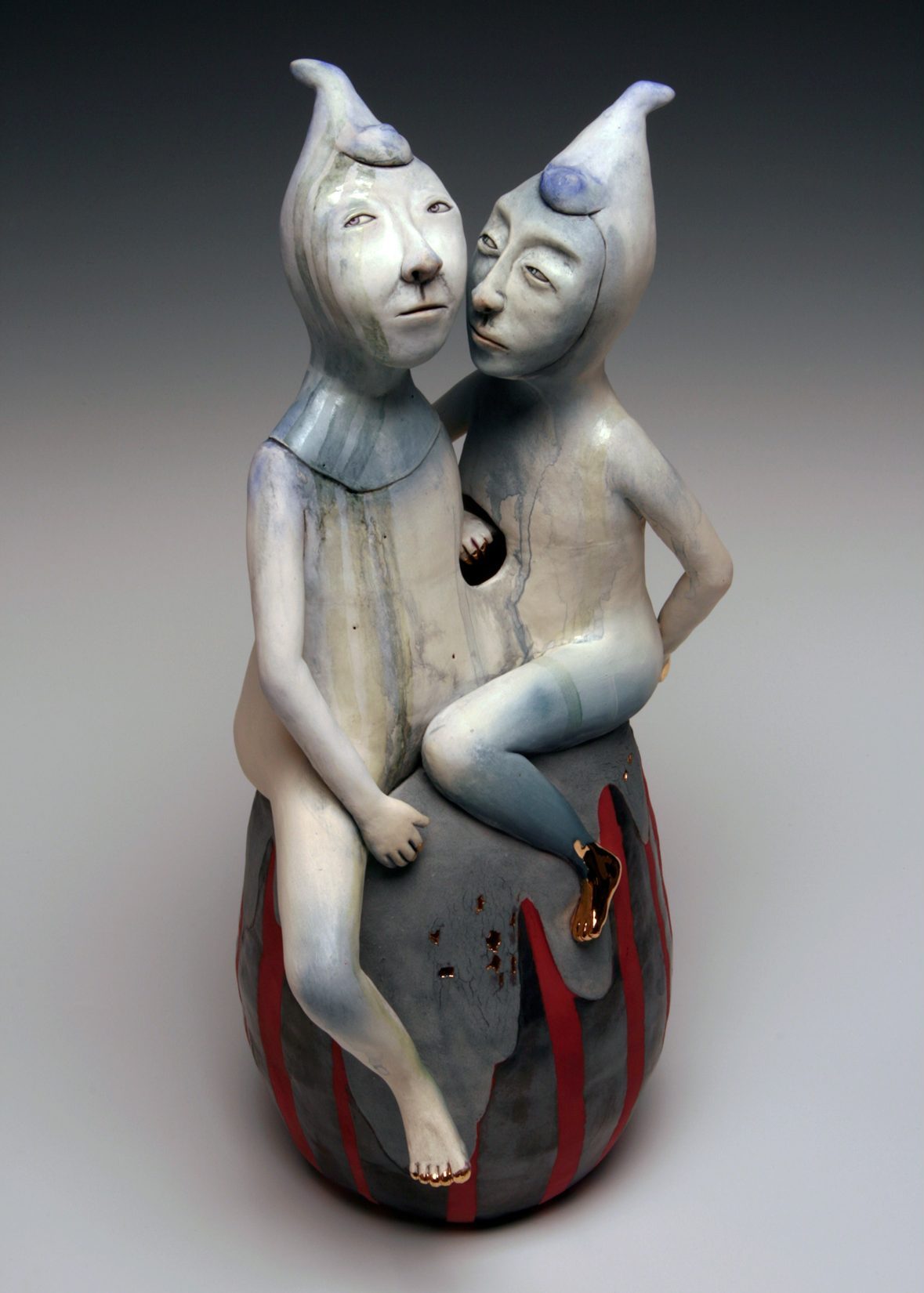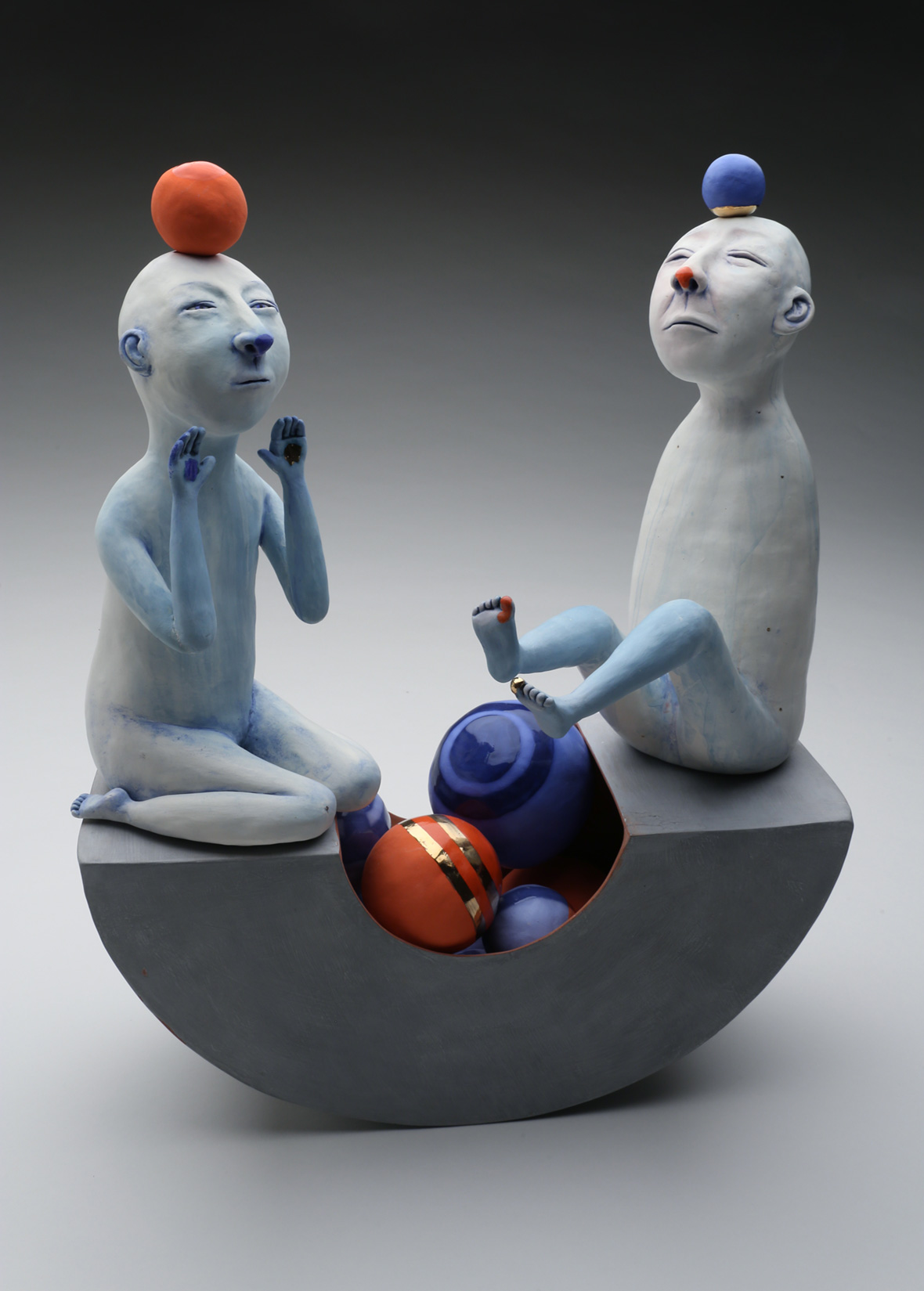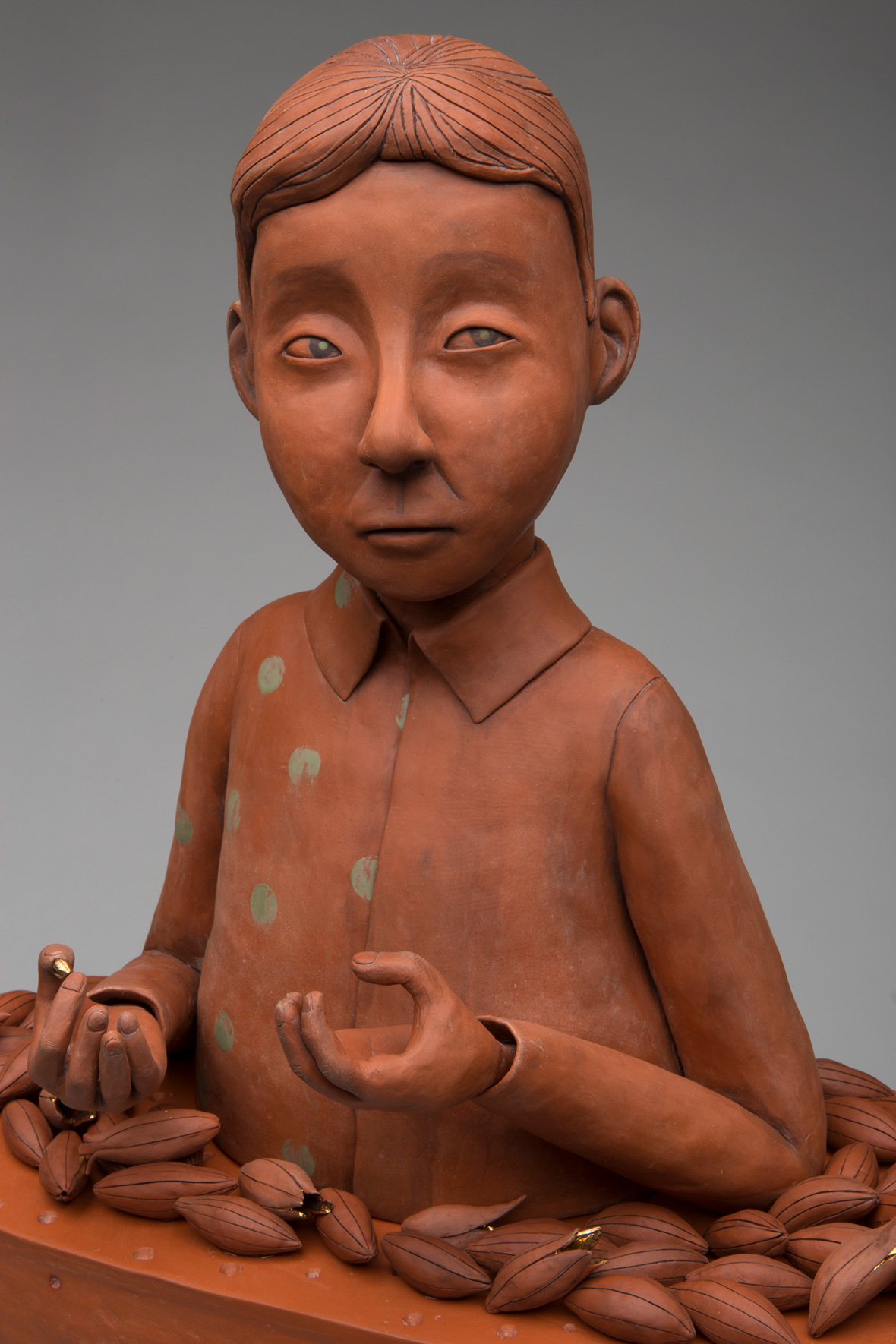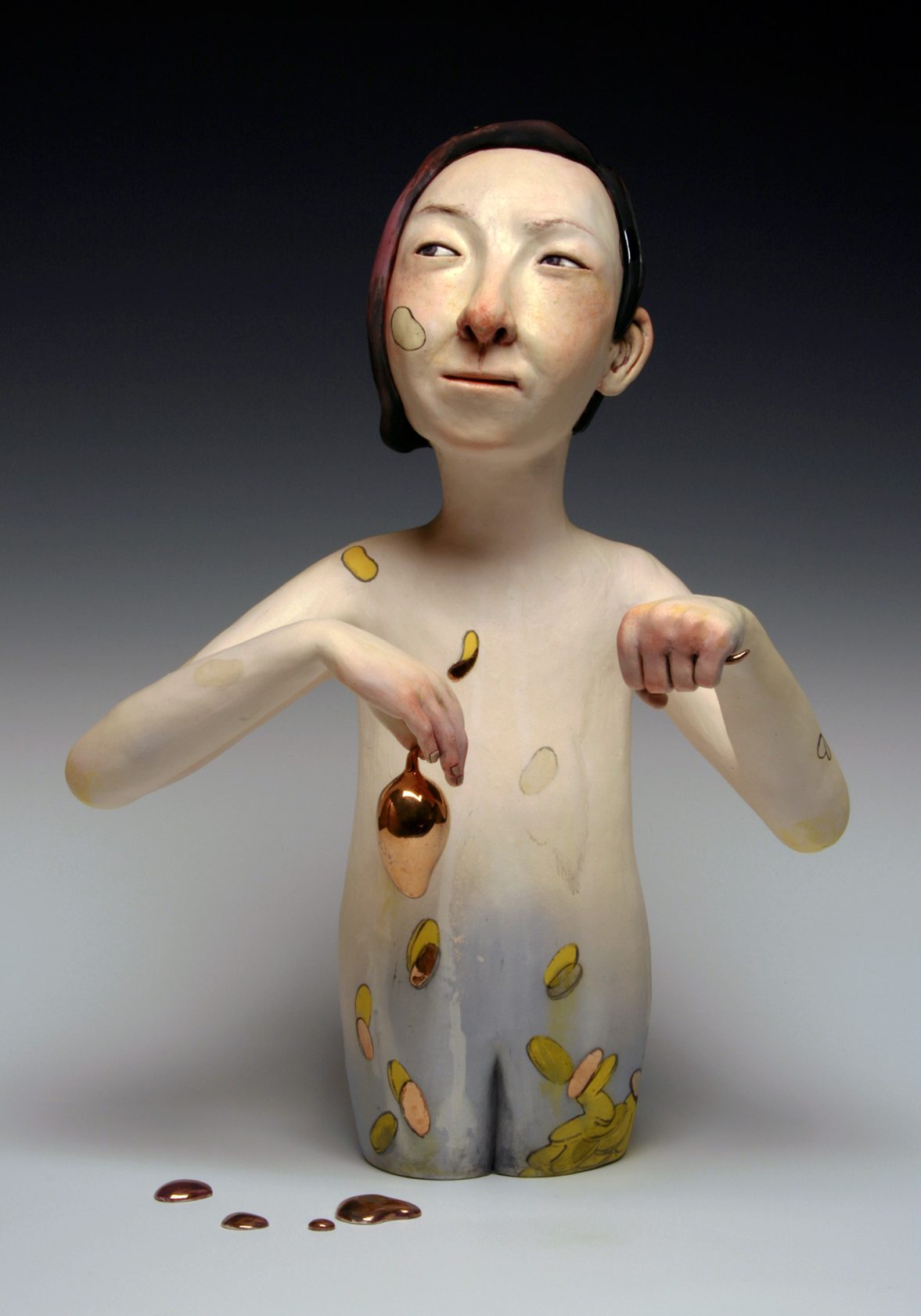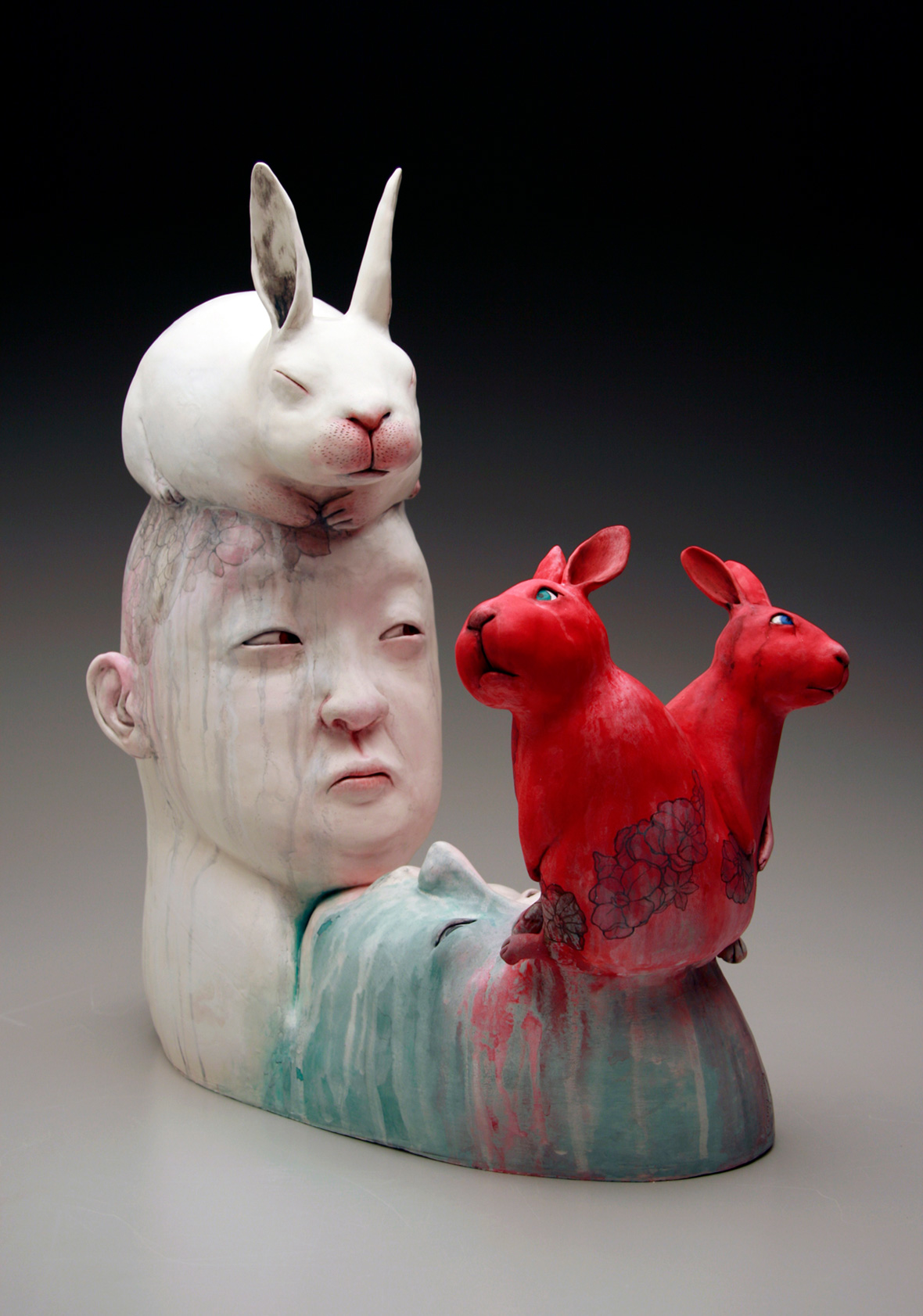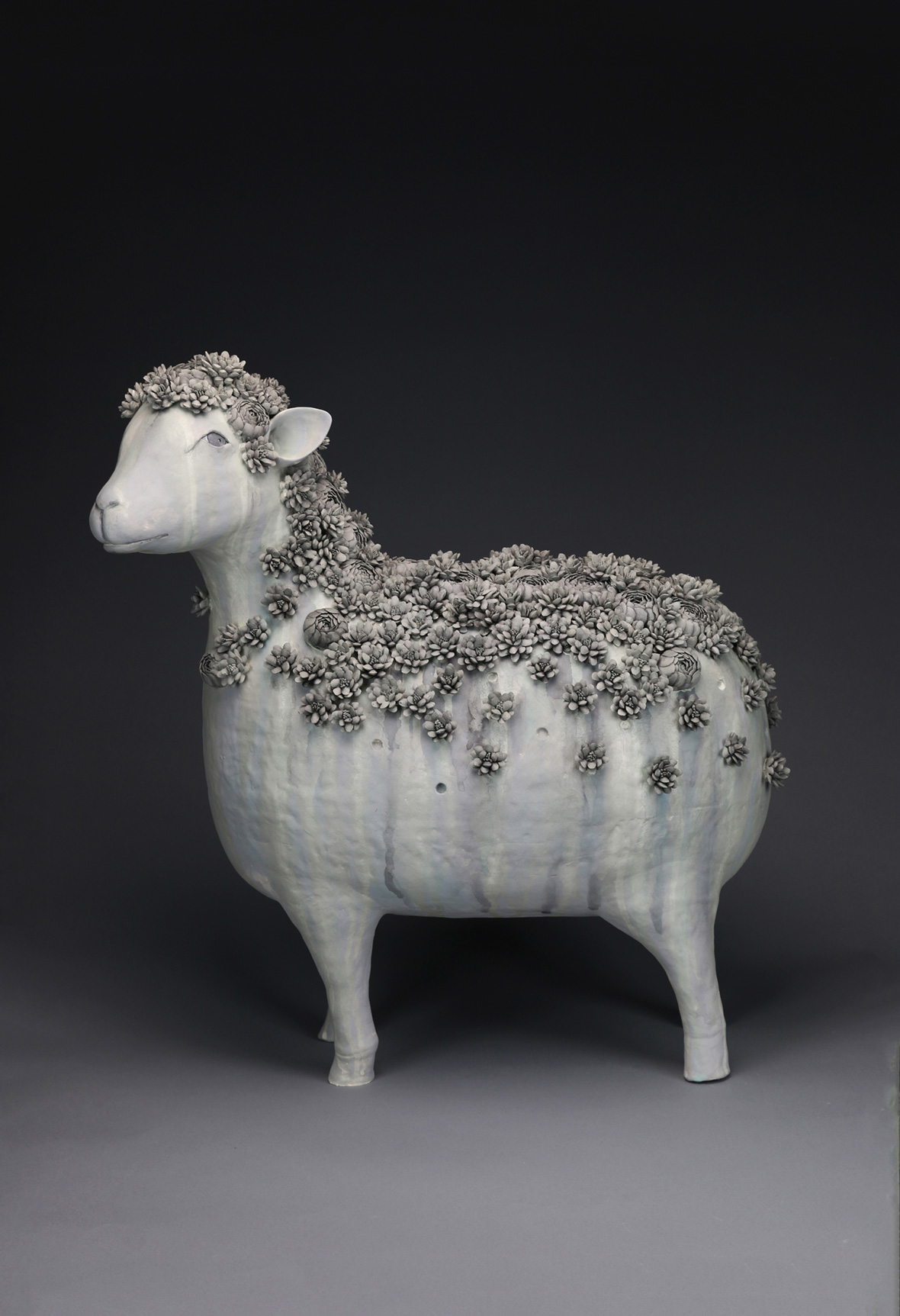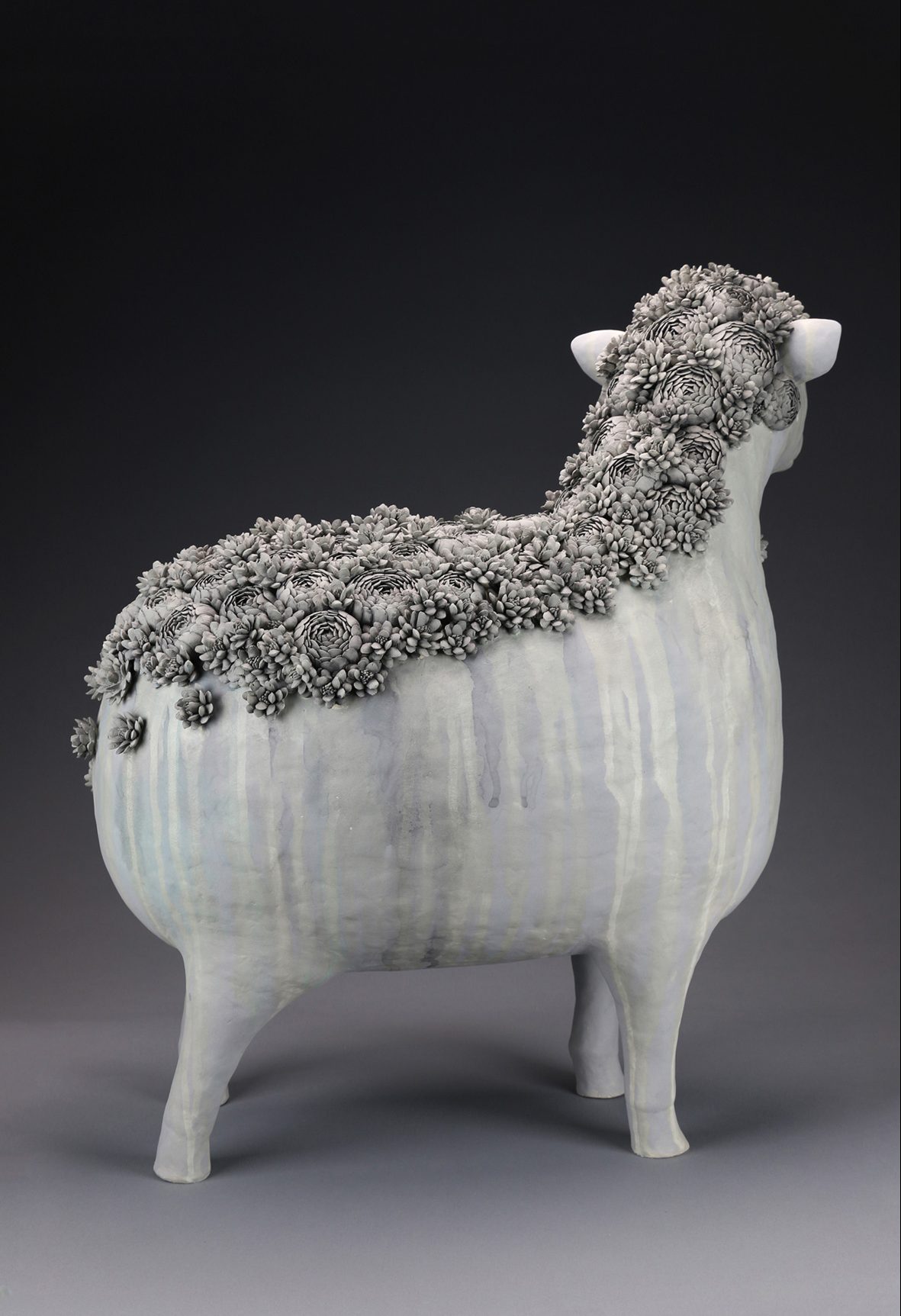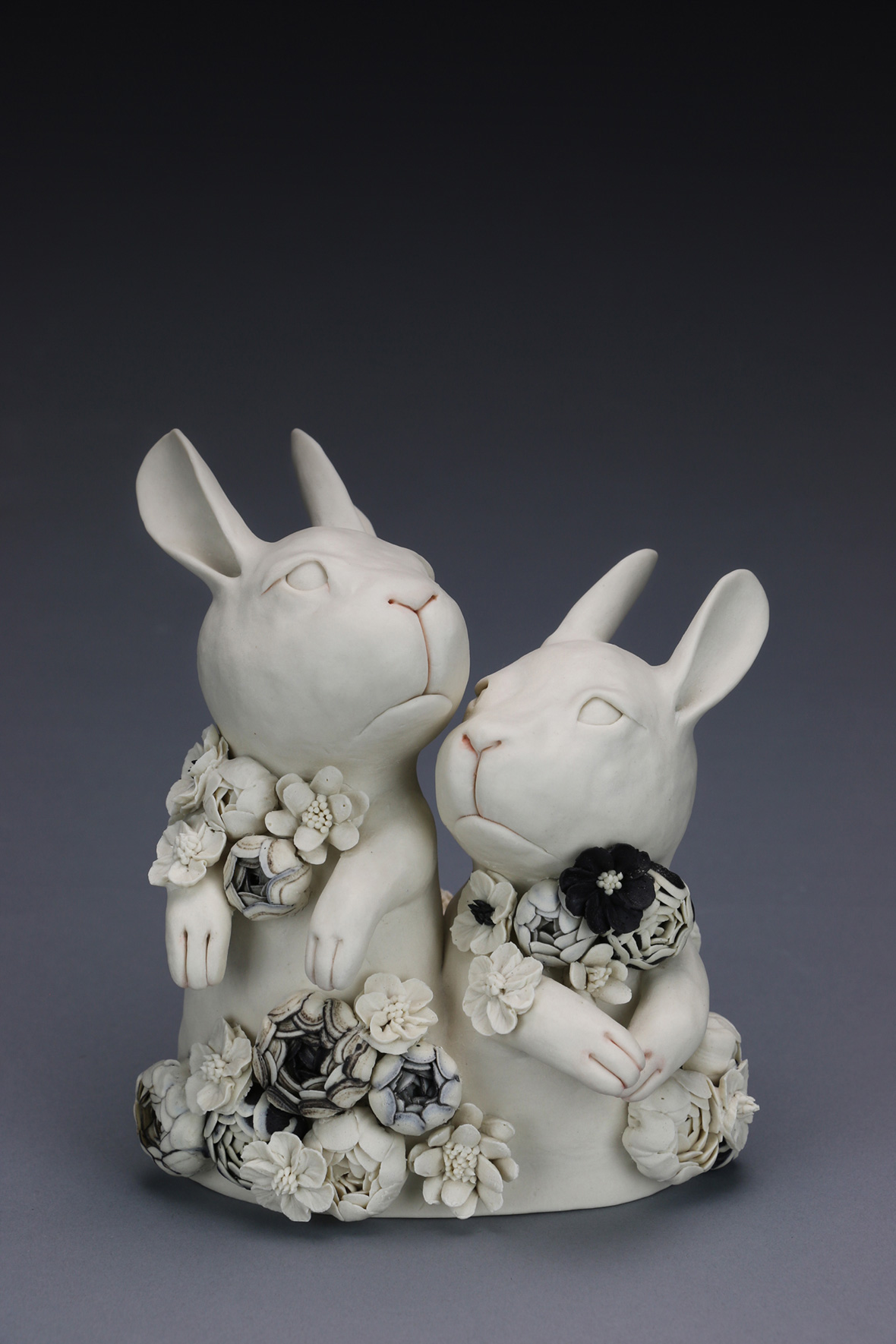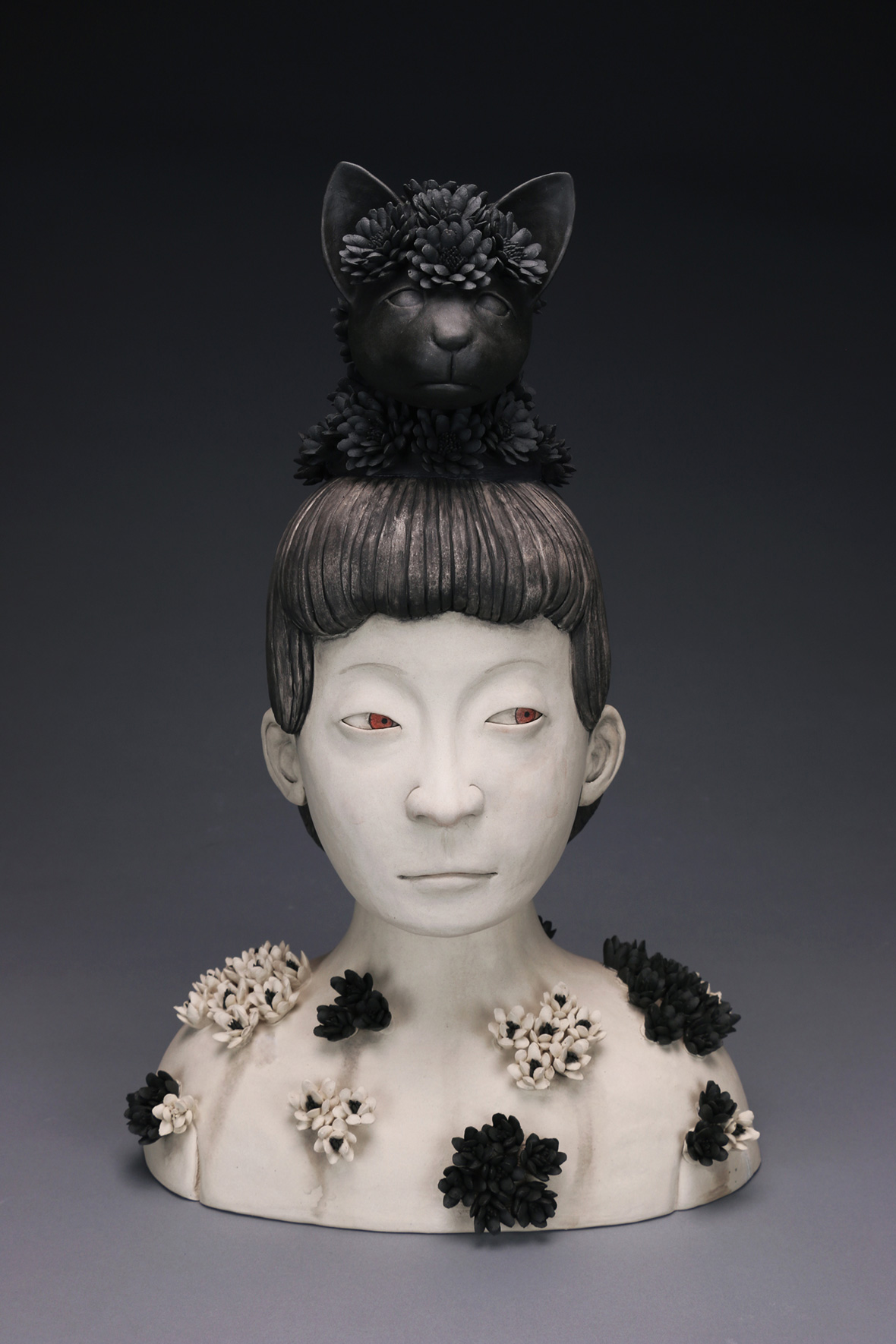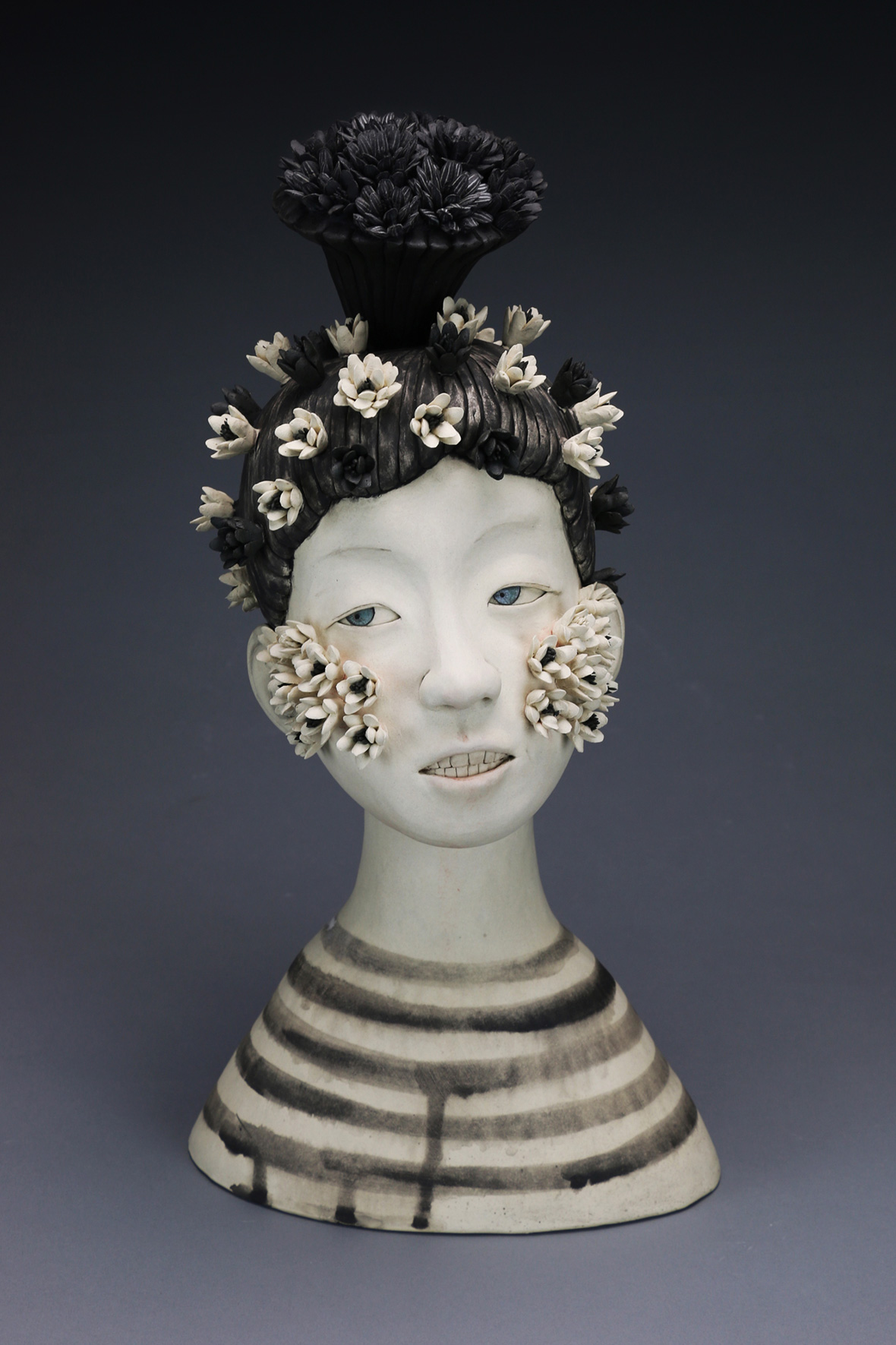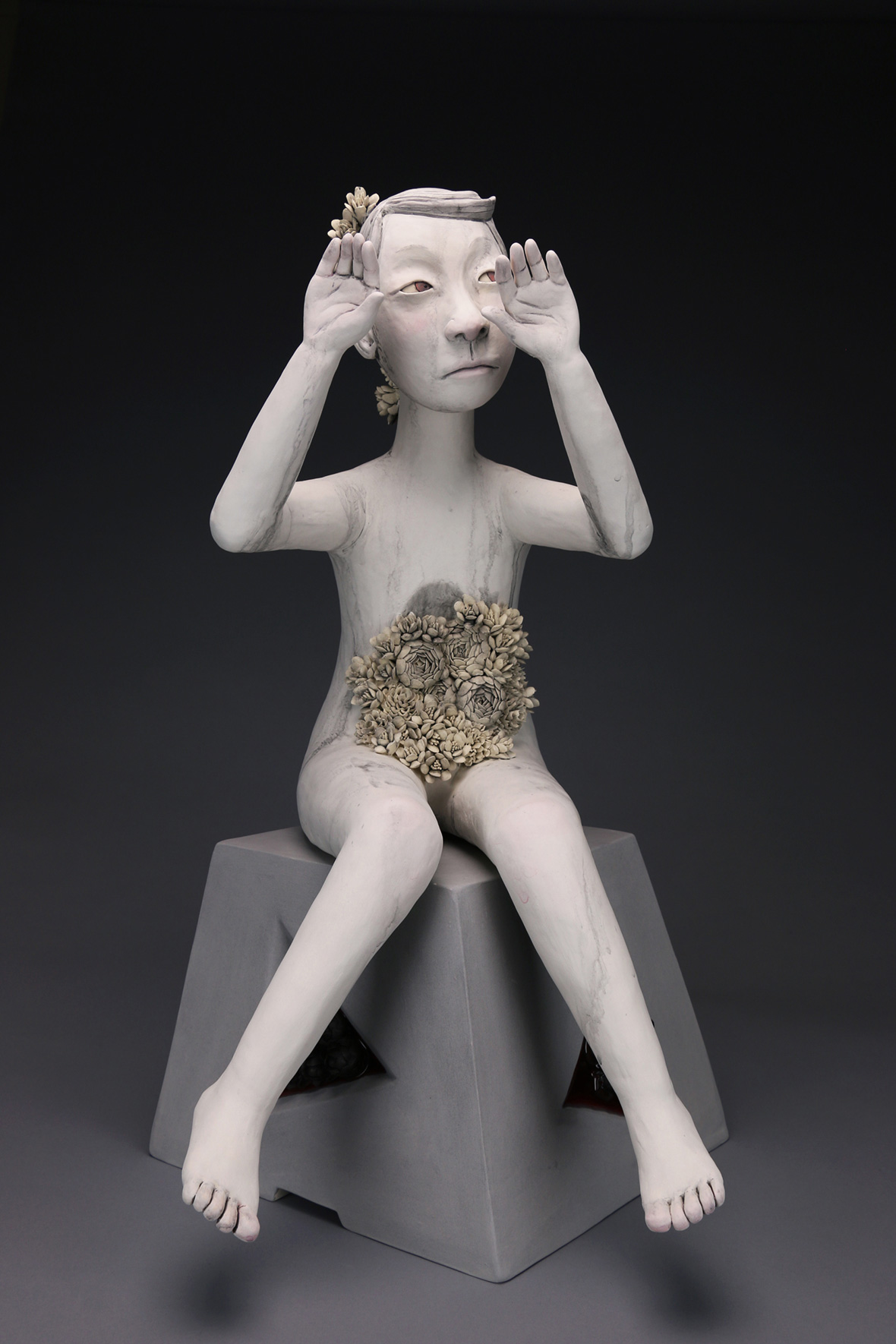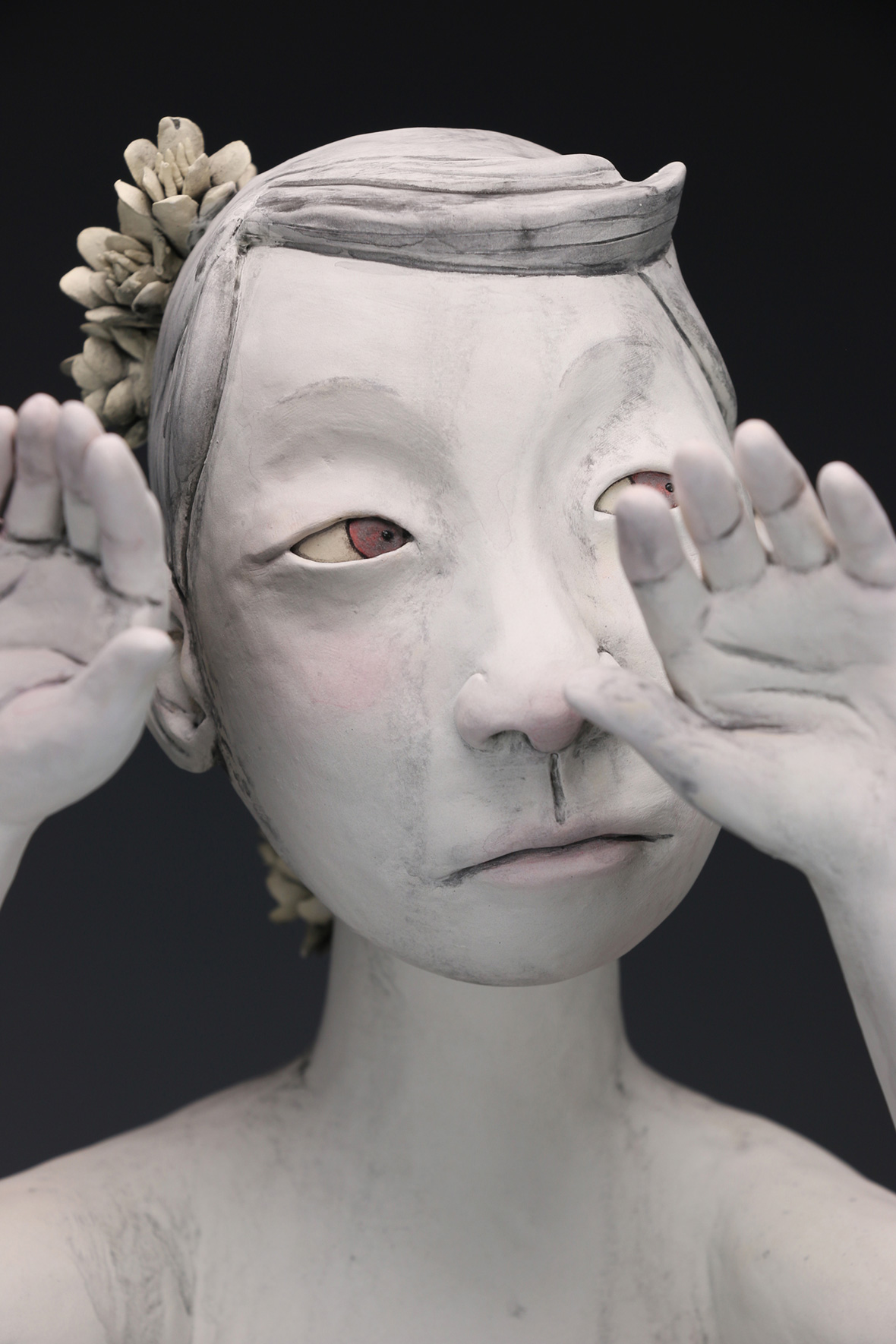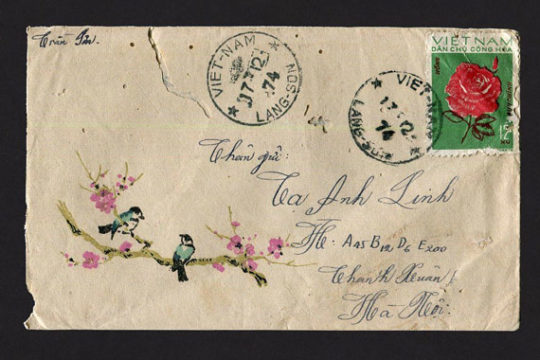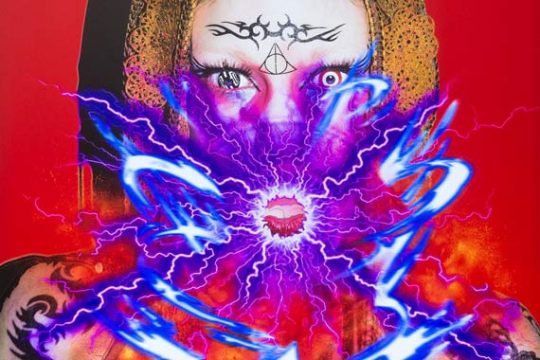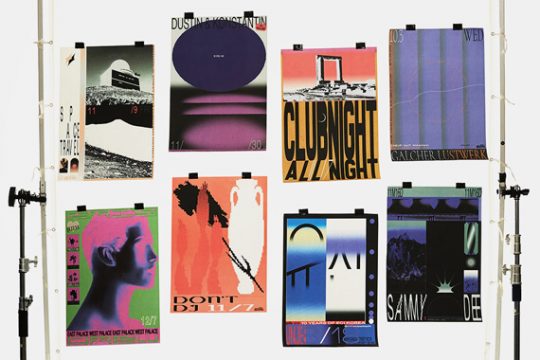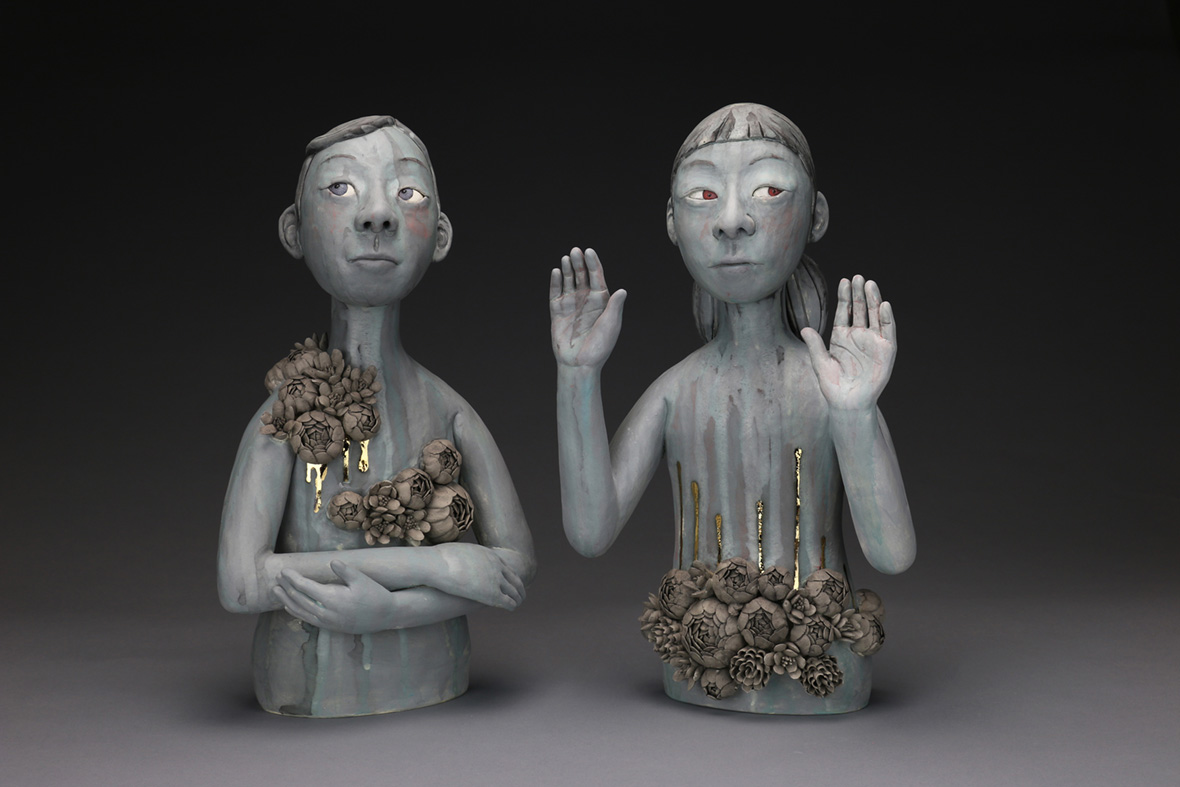
At an exhibition in Columbus, Ohio, a group of wide-eyed elementary students gather around a series of enigmatic sculpted faces argue. “That one looks like it’s sad,” says one of them. “No, it looks like it’s doing this!” another yells back, making a face. They continue to disagree, laughing at each other and defending their perspectives.
Gunyoung Kim, the artist behind the sculptures, is originally from Seoul and moved to the United States to pursue graduate studies in ceramic art. She has held residencies in Kansas and Montana, and currently lives and teaches in Ohio. She says she wants to “make art accessible to everyone”—a goal that, at first glance, seems at odds with her surrealist figures. But for her, making her art accessible doesn’t mean presenting a single, obvious meaning, but leaving it open to multiple interpretations. “I want viewers to have their own responses to my work,” she says.
在美国俄亥俄州哥伦布市的一个展览中,一群小学生正睁大眼睛,围看一组神秘的雕塑面孔,热烈地争论着。“这一个看起来很伤心。”一个小学生说道。“不,它看起来是这样的!”另一个边嚷着,边模仿雕塑做鬼脸。他们继续辩论,各抒己见,为各自不同的观点而开怀大笑。
这些雕塑的创作者 Gunyoung Kim 是一名来自韩国首尔的艺术家。她曾在美国攻读陶瓷艺术的研究生学位,并先后在堪萨斯州和蒙大拿州生活过,目前则在俄亥俄州担任教师工作。她说自己想“让所有人都能理解艺术”——乍听之下,这个目标似乎与她的超现实主义作品自相矛盾。但对于她来说,让人们理解艺术,并不意味着必须呈现单一、意义明显的作品,而是开放地让人们对于作品解读出自己的意见。“我希望观众对我的作品能有他们自己的理解。”她说。
Kim is an astute observer of expressions. “I was always interested in faces,” she says, “I don’t know why, but even when I made functional ceramics, I often drew or cast faces on them.” Part of the reason may lie in just how easy she is to talk to. Her comfort with other people allows her to make intimate observations. For the final exhibition of her undergraduate studies, she was inspired by the special needs children she’d worked with through her church for seven years. “Their faces were always difficult to read,” she recalls.“sometimes they were full of curiosity, or just really cute. It was hard to tell what they were thinking about.”
Gunyoung 是一位敏锐的表情观察者。她说:“我一直对人的面孔特别感兴趣,我也说不上为什么。即使是做功能性的陶器,我也常常会加上面孔的元素。”也许,她平易近人的性格是一部分原因。她总能让和她在一起的人感到特别舒服,这给予了她机会近距离去观察别人。在她就读本科时的最后一个展览中,她以自己在教会工作七年期间,遇到的特殊儿童作为创作灵感。她回忆说:“他们的表情很难看懂。有时候他们看上去充满了好奇,有时候只是单纯很可爱。很难猜测他们到底在想什么。”
Kim’s sculptures are inspired by faces she sees, but they’re not likenesses of anyone specific. It’s never her intention to replicate a particular face, and her medium lends itself to her art: “The really fun part about clay is that it’s super soft, so you can easily manipulate it. I never like making the exact same expression, and because there are many stages to the process I can add details or make changes as I go.” And unlike drawing, sculpting requires making a structure—shaping the head, pushing in the eye sockets, placing the eyes, etc.—which adds both variation and limitation, depending on the material used.
Gunyoung 的雕塑灵感来自于她所看到的面孔,但它们并不会类似于任何特定人物。她从来没有打算复制一张特定的脸,她的艺术完全延伸自媒介:“粘土真正有趣的部分在于它非常柔软,所以你可以很容易地操控它。我从来不喜欢制作相同的表情。在形塑的过程中有许多阶段,我可以随时添加细节或进行修改。与绘图不同,雕刻需要制作一个立体的结构——塑造头部、推入眼窝、放置眼睛等等——这增加了变化性,当然还有限制。
Given Kim’s gregarious nature, it’s hard to imagine her robbed of her voice. But when she first moved across the world to the US, she found herself struggling to overcome the language barrier. “I started thinking about my own emotions, because I couldn’t express myself. I started asking myself fundamental questions like why I was here, what I was doing or even who I was. During that time I really started to focus on my own voice.”
That voice, it turned out, had a lot to say about human relationships and emotions. “Humans are made to interact with each other,” she says. “At the time, I really started to notice how my relationships with other people impacted my emotions.” When asked about what she’s learned about human emotions through her art so far, she says, “Our feelings are always shifting and changing, and this reveals how unstable and vulnerable we are. One of the main ideas for my work is the way the complexity and ambiguity of our emotions comes from our imperfections.”
有着如此容易相处的性格,很难想象 Gunyoung 曾经失去自己的声音。当她最初移居到美国时,她曾有过语言障碍的经历。“我开始思考自己的一些情绪,因为我无法向外表达自己。我开始问自己为什么要到这里?我到底在做什么?甚至是我到底是谁?这些本质性的问题。那段时间我真的特别注意我自己的声音。”
而那个“声音”,其实与人际关系和情感是密切相关的。“人类天生必须与其他人互动。”她说。“那时候我开始关注我与其他人的关系会如何影响我的情绪。”当被问及她至今通过自己的艺术,对人的情感有什么理解时,她回应:“我们的情感一直在变化,这揭示了我们有多么不稳定和脆弱。我的作品的主要理念之一,即是人类情感的复杂性和模糊不定,来自于我们的不完美。”
Though Kim is now fluent in English and teaches workshops, she continues to study the faces around her by taking photographs. Her work is inspired by people from her personal life, and she snaps candid photos of them when they aren’t looking—not to copy these faces, but to observe details. Before sketching a sculpture, she sometimes starts by looking through her photographs. “I think I’m interacting with the photo, collecting my memories and experiences with other people. It’s part of the process.” One strange part of this, she observes, is that she finds it much more difficult to use photos of strangers. Why this is so, she isn’t sure: “It’s just a little different . . . maybe I need a connection with the person to get more information about their expressions.”
即使 Gunyoung 现在能说流利的英语,并且在工作坊担任讲师,但她仍然继续通过拍照来观察她周围的面孔。她的作品都是以她身边的人作为启发的创作,她会趁他们不注意时偷拍下照片,不是为了复制这些面孔,而是要更仔细观察他们的面部细节。在给雕塑画草图之前,她有时会先翻看这些照片。“我觉得我像是在跟自己拍的照片互动,收集那些有关人们的回忆和经历。这是创作过程的一部分。”她还发现了一个奇怪的问题:如果使用陌生人的照片,创作会变得困难得多。为什么会这样呢,她也不确定:“反正就是不太一样……也许是因为本身就认识的人,我就握有更多信息去解读他们的表情。”
Kim’s balance of the realistic and the surreal owes a lot to her artistic influences. She says she’s inspired by painters like René Magritte and Hieronymus Bosch, whose works are visionary but not abstract. “You can still see the figure and the object,” she says. This is one of the reasons she focuses on human faces: “It’s the easiest thing to understand and the most familiar form.”
In fact, she’s tried her hand at purely abstract pieces. “I appreciate abstract art and tried to make it once, but I found I couldn’t.” She recalls that as she tried to smooth and refine her work, it became more and more figurative. She naturally makes work that’s more recognizable to others. “It’s just something and enjoy, and that might just be who I am,” she says with a smile.
Gunyoung 作品中现实与超现实元素的平衡,很大程度上要归功于她的艺术影响。比利时画家马格利特(René Magritte)和耶罗尼米斯·博斯(Hieronymus Bosch)那些前卫而非抽象式的作品启发了她。“你仍然可以看到物体的轮廓和外形。”她说道,这也是她专注于创作人脸的原因之一。“(人脸)是最容易理解、也是人们最熟悉的一种形式。”
事实上,她尝试过创作纯抽象作品。“我很欣赏抽象艺术,也试过创作这类作品。但我发现自己做不到。”她回忆道,当她试图润饰、完善自己的作品时,作品往往会变得越来越可辨认。她在创作时总是不自觉地倾向具象化。“我还是比较享受创作这样的作品,可能我就是这样子吧。”她笑着说道。
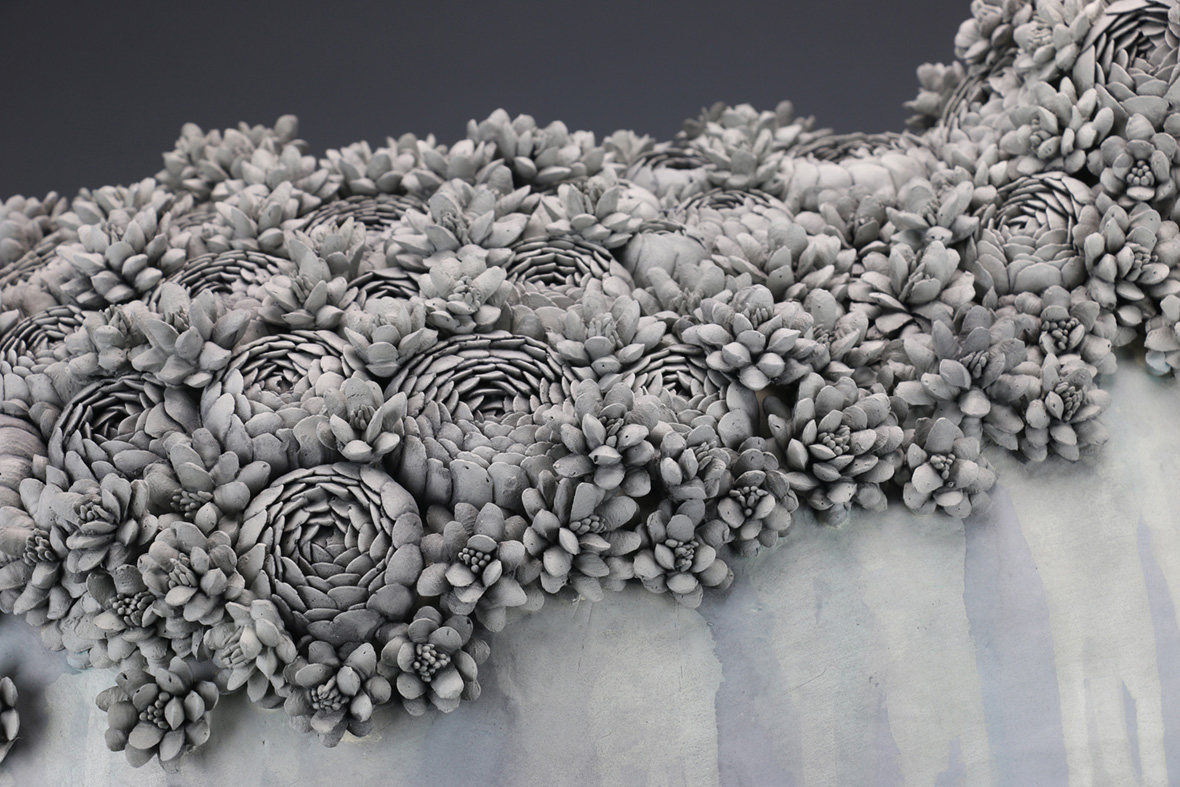
More recently, Kim has expanded her art to include animals and address issues of gender and religion. She says she started making animals when she worked in a studio set in Montana’s stunning natural scenery. “I saw bunnies and deer everyday, and I found the animals really funny because they behaved like humans sometimes.” She chooses animals that are frequently prey because she sees them as more similar to humans, allowing them to easily personify human emotions.
Kim’s newfound interest in animals developed into her newest project, “My Burden.” This complex series, featuring rabbits, sheep, and humans, encapsulates her growth as an artist. What began with the ambiguity of facial expressions has matured into an intersection of larger ideas, such as femininity and spirituality. The highlight of the series is a piece showing intricate flowers strewn across a sheep’s back, at once beautiful and fragile. Asked about their significance, Kim says she was inspired by her Christian faith, which emphasizes beauty in pain. For her, this duality is part of a more universal human experience. “Hardship and pain never go away, but remain a part of us—they somehow harden and become beautiful.”
最近,Gunyoung 扩大了自己的创作范畴,开始创作有关动物、性别和宗教主题的作品。她说,自从在蒙大拿州一个风景迷人的工作室里工作后,她就开始创作动物题材。“每天我都可以看到兔子和小鹿,我发现这些动物真的很有趣,因为他们有时候表现得简直跟人类一样。”她选择一般都是猎物角色的动物当作题材,因为在她看来这些动物更类似于人类,也更容易传达人类的情感。
对动物的新兴趣启发她创作新的项目《我的负担》(My Burden)。这个复杂的系列作品包括兔子、羊和人类,也体现出她作为艺术家的成长,从最初描绘带有不确定性的面部表情,发展成更宏大想法的展现,如女性特质和精神性。在这个系列作品中,最引人注意的是一幅羊背上散落花朵的作品,看上去既美丽又脆弱。当被问及作品的含义时,Gunyoung 说,这个作品是以她的基督教信仰为灵感创作的,这种信仰强调了痛苦之美。对她来说,这种双重性是一个更普遍的人类经验。“忧患与痛苦永远不会消失,永远是我们的一部分——它们会随着年岁逐渐坚固,变得迷人。”
Flowers bring to light another dimension of Kim’s work. She’s amused by the way people frequently associate the delicacy of flowers with femininity, because in working with them, she’s realized flowers are also “heavy, rough, sharp and brittle.”
Gender is of little concern in molding her figures, she says. “Some people think that because my figures have a certain kind of hair that it’s a man or a woman, but I don’t really pay attention to that while making them.” As Kim continues to develop as an artist, the ambiguities of her work will no doubt grow ever deeper and more dense. The children who enjoyed her work might one day return to find much more debate than just faces.
花卉让她的作品提升了一个新的维度。她说,人们常常将花的柔弱与女性联想在一起,这其实是很可笑的。因为她在创作时发现,事实上,这些花其实“沉重、粗犷、锋利又冷淡”。
她在创作人物雕塑时其实很少会关注性别,她说:“有些人认为,因为我的雕塑有某种发型,那它就是男人或是女人,但我在创作时真的没有在考虑这一点。”作为一个艺术家,Gunyoung 仍在不断进步,她的作品中的不确定性也将变得更有深度,更加强烈。而今天这些围观她雕塑作品的孩子也许会在长大后的某一天重新审视她的作品,发现除了雕塑的表情外,还有更多值得争论的事情。
Website: gunyoungkim.com
Instagram: @ggunyoung9
Contributor: Eugene Lee
Chinese Translation: Olivia Li

